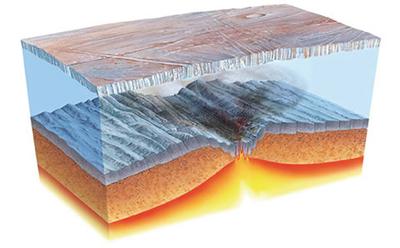Explosive volcanism drove major changes in ‘Snowball Earth’ ocean chemistry

Around 720-640 million years ago, much of the Earth’s surface was covered in ice during a glaciation that lasted millions of years. Explosive underwater volcanoes were a major feature of this ‘Snowball Earth’, according to new research led by the University of Southampton.
Many aspects of this extreme glaciation remain uncertain, but it is widely thought that the breakup of the supercontinent Rodinia resulted in increased river discharge into the ocean. This changed ocean chemistry and reduced atmospheric CO2 levels, which increased global ice coverage and propelled Earth into severe icehouse conditions.
Because the land surface was then largely covered in ice, continental weathering effectively ceased. This locked the planet into a ‘Snowball Earth’ state until carbon dioxide released from ongoing volcanic activity warmed the atmosphere sufficiently to rapidly melt the ice cover. This model does not, however, explain one of the most puzzling features of this rapid deglaciation; namely the global formation of hundreds of metres thick deposits known as ‘cap carbonates’, in warm waters after Snowball Earth events.
The Southampton-led research, published in Nature Geoscience, now offers an explanation for these major changes in ocean chemistry.
Lead author of the study Dr Tom Gernon, Lecturer in Earth Science at the University of Southampton, said: “When volcanic material is deposited in the oceans it undergoes very rapid and profound chemical alteration that impacts the biogeochemistry of the oceans. We find that many geological and geochemical phenomena associated with Snowball Earth are consistent with extensive submarine volcanism along shallow mid-ocean ridges.”
During the breakup of Rodinia, tens of thousands of kilometres of mid-ocean ridge were formed over tens of millions of years. The lava erupted explosively in shallow waters producing large volumes of a glassy pyroclastic rock called hyaloclastite. As these deposits piled up on the sea floor, rapid chemical changes released massive amounts of calcium, magnesium and phosphorus into the ocean.
Dr Gernon explained: “We calculated that, over the course of a Snowball glaciation, this chemical build-up is sufficient to explain the thick cap carbonates formed at the end of the Snowball event.
“This process also helps explain the unusually high oceanic phosphorus levels, thought to be the catalyst for the origin of animal life on Earth.”